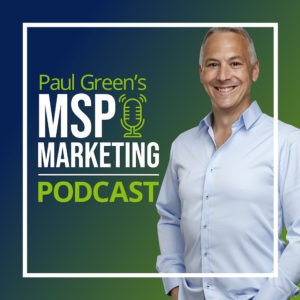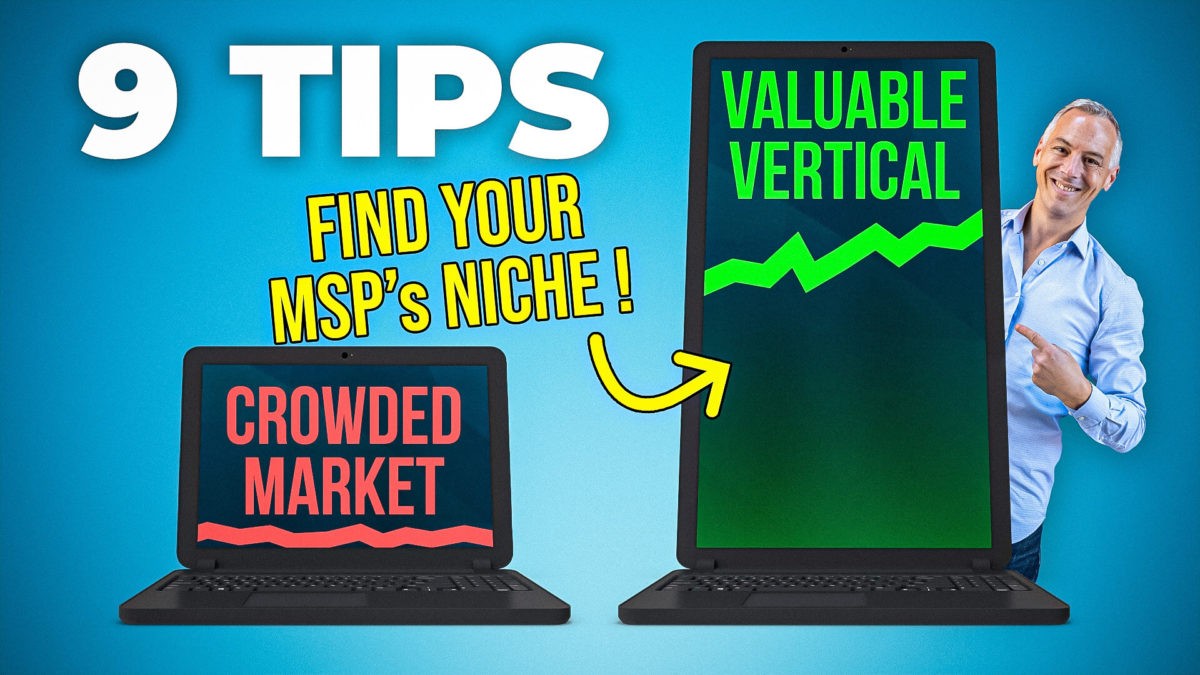
The podcast powered by the MSP Marketing Edge
Welcome to Episode 254 of the MSP Marketing Podcast with me, Paul Green. This week…
- 9 MSP marketing ideas to break into a new vertical: One of the easiest ways to grow your MSP is to target a vertical. Marketing to a vertical is so much easier than marketing to a general audience.
- How to stand out at networking meetings: To get the most from networking meetings you have to stand out but in the right way, in the most authentic way. And I’m going to tell you exactly how to do that.
- How to find another MSP for sale, and start a conversation: One of the fastest ways to scale a business is to acquire competitors and absorb their clients into your business. My guest, Jonathan Jay, shares his expertise on this subject.
- Paul’s Personal Peer Group: Fiona, from an MSP in New Hampshire, wants to know more about exit intent popups – do you use these on your website yet?
9 MSP marketing ideas to break into a new vertical
One of the easiest ways to grow your MSP is to target a vertical. Marketing to a vertical is so much easier than marketing to a general audience because you know exactly who you are marketing to, exactly where they are, exactly what their problems are, and how you can solve those problems. So you can make your marketing message sound so much more relevant to them. A lawyer, for example, is much more likely to listen to you if you are using the word lawyer than if you are just talking about business owners.
Let me give you nine, rapid fire marketing ideas to break into a new vertical. So there are many benefits of marketing to a vertical. You can do it alongside your general business, and once you’ve picked a vertical, there are a number of actions that you should take to get your marketing properly set up.
Here are the first nine actions that I recommend, in the order that you should do them.
Number one: Build a website just for that vertical. Not just a new page on your existing site, do it properly. Put together a four to five page website just for that vertical. The goal is to appear to be a true specialist to your target prospects, and a proper website is a basic MSP marketing fundamental.
Number two: Set up a vertical specific LinkedIn or Facebook, depending which platform most decision makers in your vertical use.
Number three: Start posting regular content so that you have a presence. Make sure to put the name of the vertical into the headline and/or the intro paragraph. Now, sometimes making content seem relevant to a vertical is as simple as mentioning that vertical and also look for how they refer to themselves and their business. So for example, accountants have a practice, not a business.

Number four: Start networking and meet as many decision makers as you can. Look for relevant vertical business shows or other events that you can attend, as nothing beats pressing the flesh when you’re just getting started in a vertical. I promise you’ll have a marketing revelation at every event.
Number five: Build your email list. It’s easy to get started with a vertical because you can just buy targeted data. You can also scrape Google or get a virtual assistant to just go through Google searches and make a database up for you.
Number six: Get your marketing machine working, generating prospects that you can speak to doing all the things we’ve just been talking about, and then pick up the phone and call them. Phone calls will always get you to a new client faster.
Number seven: Once you have a vertical client, turn them into a case study or a testimonial as quickly as you can, and this will give others the faith to buy from you.
Number eight: Look for other forums where your vertical decision makers hang out. Do they have Facebook groups, LinkedIn groups, chat forums… can you become a member of these? Best to do this properly and above board rather than try to sneak in. And don’t try to sell; add value by answering relevant questions. Just make sure there is a link to your vertical website in your profile.
And then finally number nine: Get to know the movers and shakers in your vertical associations. You are ultimately serving the same people, so be persistent in getting to know them, but do play a long game. The key question to ask is – what do these influencers want or need and how can I help them get it? If you help them, of course at some point they’re going to help you.
How to stand out at networking meetings
Let’s talk about networking. And I don’t mean the enjoyable networking with cables and that lovely sound it makes when the plug goes into the socket, that *bink*. No, I mean the networking that’s less enjoyable where you’re getting up early, overpaying for an unhealthy breakfast and getting stuck in a corner, being bored by strangers in order to get the most from the networking meetings that you go to. You have to stand out but in the right way, in the most authentic way. And I’m going to tell you exactly how to do that.
Now I haven’t been networking for a while, but I did once go to a networking meeting where there was a guy dressed in a bright gold, lamé jacket so that he could stand out. I’m not kidding at all. No one took him at all seriously because he just looked like an out of work magician.
The best way to stand out at a networking meeting is not to wear a gold, sparkling jacket – it’s to be INTERESTED, not INTERESTING.
Essentially what I mean is you shouldn’t try to stand out by standing out, by going, woo-hoo, look at me.

Instead, work the room. Make every person feel like they are the most important person there. Give them your full attention with no distractions. Have a poker face if they’re boring, and just ask them lots of open questions about their favourite subject, which is of course, themselves and their business. If they ask any questions back about yours, just give them a one line answer and then flip it around and ask another open question.
Here’s the thing about talking to relative strangers. The less you talk about you, the more fascinating you will be to them. I promise you that’s true. After 10 minutes or so, when you are kind of in that zone where you’re starting to get bored of each other, suggest that you swap business cards and say, Hey, we should go meet some other people, or you and I are going to be chatting all day, as you’re such a fascinating person. Maybe that last line doesn’t quite sound so authentic, but just make sure that the business card you give them has your most recent photo on it, because in reality that’s all they’re going to remember about you, your face. They’ll remember your face, they’ll remember how your face made them feel, and they’ll keep your card. The ideal thing then is, once they’ve got your card, they’re pulling it out three or four weeks later and they’re looking at it like, oh, I remember that person, they were fascinating. And of course, your business card says exactly what you do. Tell me, what’s your advice to really max out a networking event?
How to find another MSP for sale, and start a conversation

Featured guest: Jonathan Jay fell into mergers and acquisitions (M&A) by accident in 1999 with the sale of his publishing business. Fast forward a few years and he’d bought out a large competitor in another sector, merged it with his existing business, and sold it on to a London-based private equity firm in 2007 in a life-changing deal.
Jonathan bought a group of insolvent businesses from a Private Equity firm for £1, turned them around, and sold them 11 months later for £1.25m, and during the pandemic he bought another 48 businesses.
After being asked to share his business buying knowledge, Jonathan founded The Dealmaker’s Academy in 2016. Since then, Dealmakers.co.uk has become the leading M&A educator in the UK, and Jonathan has taught more than 13,500 people worldwide how to buy their first business.
There are very few shortcuts to growing your business, but one of them is to acquire another MSP. In a single transaction, you can double your revenue and down the line dramatically increase your profits as well. But of course, doing this kind of acquisition is not easy. Never mind the hassles of integrating two businesses. Most MSPs fail at the very first hurdle, which is how to know which MSPs could be for sale and how to start a conversation about that.
My guest has bought and sold so many businesses, he’s going to make it really easy for you. Today’s guest will tell you how to find another MSP for sale and start a conversation about acquiring them.
Hi, I’m Jonathan Jay from Dealmakers.co.uk
And thanks so much for coming back onto the podcast. Jonathan, I think it’s about to get on for three, maybe four years since you were last on. And I know that you’ve been very busy. You’ve been teaching thousands of business owners around the world, including many MSPs, how to find and buy a competitor or another MSP and add it into their own business. And we’re going to talk about exactly that on this interview.
Now, before we jump into that, and I know everyone who’s thinking of buying an MSP always has the same questions which you’re going to answer for us. First of all, tell us a little bit about you. So what’s your background and how did you get into buying and selling businesses?
Sure. So, 2024 is actually my dealiversary, so 25 years ago, I first sold a business. It was a publishing business, someone approached me. I made more money the day I sold it than I had in the previous two and a half years of turning up to the office six days a week. My eyes were open to what was possible, but it takes me a while to learn a lesson.
I actually started another business from scratch, which we all know is a lot of hard work. But then I bought out my major competitor, put the two businesses together, and then sold that to private equity in 2007, and that was a life-changing deal. And even now, 18 years later, that deal is paying for my holidays, it’s paying for my lifestyle. So I always say to people, one deal can change your life. And over the last 25 years, I’ve bought and sold more than 75 different businesses and I’ve learned a lot along the way and I’ve made all the mistakes so that you don’t have to.
It’s so amazing to hear a story like that where you are still living off that one deal from 18 years ago. But is that what every MSP owner can expect when they start to do mergers and acquisitions? Or do most people start off with something a bit simpler like just buying a competitor?
Well, I tell you the mistake that most people make – they buy another business, but they buy a business that’s way too small. They buy someone who’s smaller than they are because it’s inside their comfort zone, instead of buying a business that’s actually bigger than theirs. Now, when you buy a business that’s bigger, it’s actually easier to do the deal. It’s easier, interestingly, to negotiate a deal with a larger business, it’s easier to finance the acquisition, and they typically have more professionalised accounts and financial functions. So it’s actually easier to understand the business that you are buying.
The number one mistake that people make is buying too small, getting frustrated, and therefore not doing it again.
But what are the common objections that you hear from people when you suggest that? A few off the top of my head that I can imagine people saying, but Jonathan, I’ll never be able to afford a bigger business, but Jonathan, they’ve got a management team and we haven’t, but Jonathan, that’s just ridiculous. I’m guessing you hear these and more.
Yeah, so let me tell you the mindset shift that needs to take place. The mistake that people make is they start thinking, how can I afford this business? I want to buy it, but how can I afford it? And they start thinking about their savings and their pensions, and they start thinking about friends and family who could lend them money. They don’t really want to go to the bank because the bank turned them down for a £10,000 overdraft, so they don’t think the bank’s going to be much help. So they give up because they’re actually asking themselves the wrong question. You see, when you ask yourself the question, how can I afford it? You go down a certain thought pattern of how much cash have I got at the bank and how much money can I borrow? The question you should be asking yourself is, how can I fund it?
So if I was to buy this business, how can I fund it? Now, what we want to do, we want to fund the acquisition of this business without putting in any of our personal money. And that’s a very important rule that I live by. You never put in your personal money. Now, if you take yourself out of the equation and you start saying to yourself, how can I fund this? You take the knowledge that you’ve acquired about funding businesses, and all of this is learnable. You take all that information, learn about funding businesses, and you create what we call a deal jigsaw where we take all these different elements of funding, we fit them together, and we create the ability to buy that business without putting in any of our own cash.
And do you see, if we take MSPs as a specific example, because I know you work with all sectors everywhere across the world. Do you see that actually someone buying another business like theirs, whether it’s a bigger one or a smaller one, are they more likely to succeed with that because they already understand the business and therefore they know where the costs can be cut and where corners can be cut and where corners can’t be cut?
Yeah, 100%. The mistake that I see people make is they buy a business that they don’t understand, and then when they’ve got it, they don’t know what to do with it. They don’t know what’s good about it, what’s bad about it. And it is a really easy trap to fall into. But if you are buying a business that’s similar to yours in a different location, maybe even in a different country, you understand what you are buying. You know what to look for. You can look at their accounts and you can understand whether you think they’re spending too much money on staff, their overheads are too high, they’re spending too much on their office, and as a result, you can see savings, but you can also see synergies. You can say, well, if we buy that business that’s in the next town, do we need their office as well? Do we need all of their staff? Could we merge the two together? And those cost savings just drop straight to the bottom line to create more profit and more money in your pocket.
Yeah. So I guess theoretically you could use the increased profits from that to help you fund the deal. So it’s almost like you’re taking the profits that you’re going to realise down the line and you are using those to pay off the owner down the line. Is that the kind of thing that you’d put together in your deal jigsaw?
I don’t believe that you should ever agree a fixed price for a business. And the reason I say that, and it’s very different to what you will hear from anyone else, is because businesses go through ups and downs. They go through cycles of high performing, moderately performing and having a tough time and then back having an amazing time. So I think that you should always agree a price for a business that is related to the results, there is a connection between the two. And that means that if the business performs, the seller gets more. But if they’ve sold you something that’s about to fall off a cliff and isn’t going to perform and they kind of know that they just can’t wait to offload it onto you, then they get less because the business isn’t performing. And what that does, it completely de-risks the acquisition. And I’m all about de-risking the acquisition so that you are not left with a problem.
Yeah, I love this. And actually, I’ve been watching your YouTube channel and you have some fascinating videos on there where you are talking to people that you’ve taught how to go and acquire a business. And a lot of the things you’ve just said there, it’s great to hear your clients, your students I guess, it’s hard to call someone who’s in their forties or fifties a student when they’re running a successful business, but to hear them saying that they’ve done exactly that, which is really cool.

Okay, one final question for you, and it’s kind of a get started question. So let’s assume we’ve got an MSP who’s watching this on YouTube or listening to this on the podcast thinking, oh yes, this is it. I want to do this. Where do they start? Because I know that’s the question that I most commonly get about M&A is, where do I find other MSPs for sale?
So the simplest thing to do is to go to the people already in your contacts, people that you already know, and you don’t ask them if they would like to sell to you and you don’t say, I want to buy your business, because that’s just sending completely the wrong message. This is what you say, and you say this word for word. You say, if you were ever thinking about selling your business, would you let me know? Okay. An alternative to that is to say, do you know anyone who’s selling their MSP? And in both cases, what we’re doing in a very soft way is we’re saying we are interested, but we are allowing them to contact us, maybe not immediately. But maybe a few days later, they might say, look, you asked me that the other day and I’ve been thinking about it. I think I might be interested. It’s a very, very gentle, polite, and professional way of starting the conversation without the bluntness of, do you want to sell your business? Which I think probably won’t get you the response that you’re looking for.
Yeah. That’s fantastic. Thank you, Jonathan. So tell us more about what Dealmakers does and how can you help MSPs to acquire another MSP, and what’s the best way for us to get started with you?
We help people in over 56 countries around the world buy businesses, whether it’s their first business or they’ve already bought some businesses, but they want to do it bigger and better. And I’ve got lots and lots of free resources to give away, and you can find them on Dealmakers.co.uk. All you have to do is download the free resources, and if you need any help at all, just send us a message.
Paul’s Personal Peer Group
This week Fiona, who heads up the marketing for an MSP in New Hampshire, asks – In terms of websites, I’ve heard about exit intent popups… what is it and should I have one on our website?
One of the most important ingredients you need in your website is a strong call to action, also known as a CTA. This is the thing you most want them to do after visiting your site. Your main CTAs are likely to be in order of priority: number one, book a 15 minute appointment with you through your live calendar. If they don’t do this, you want them to, number two, go through your data capture. And if they don’t do this, then you want them to, number three, connect with you on LinkedIn.
An exit intent popup spots when someone’s intending to leave your webpage and displays a popup. Is it annoying? Well, yes, a little bit, but does it get conversions? And the answer to that is also, yes. We used to use one on our website some time ago, and we got probably around two or three people a week joining our mailing list. Now, that’s not huge, but over the years, it does add up. We custom built ours. Popular tools available, include Hello Bar, Wise Pops and OptiMonk. And of course there are dozens of WordPress plugins that will do exactly the same thing.
Mentioned links
- This podcast is in conjunction with the MSP Marketing Edge, the world’s leading white label content marketing and growth training subscription
- Join me in MSP Marketing Facebook group.
- Connect with me on LinkedIn
- Connect with my guest Jonathan Jay on LinkedIn and check out the Dealmakers website.
- Got a question about your MSP’s marketing? Submit one here for Paul’s Personal Peer Group.
